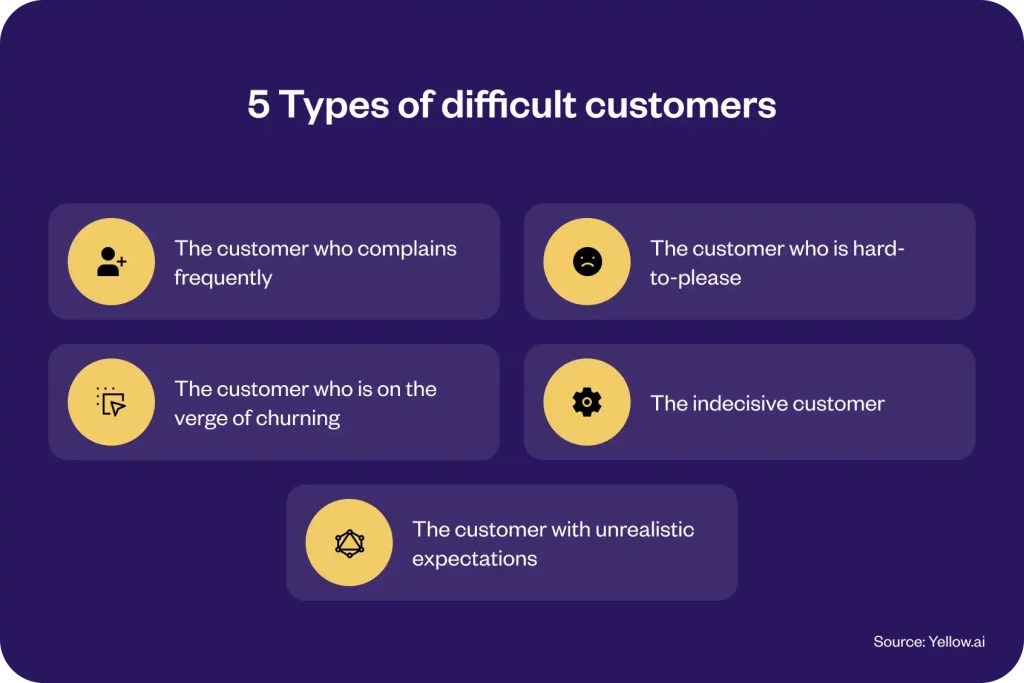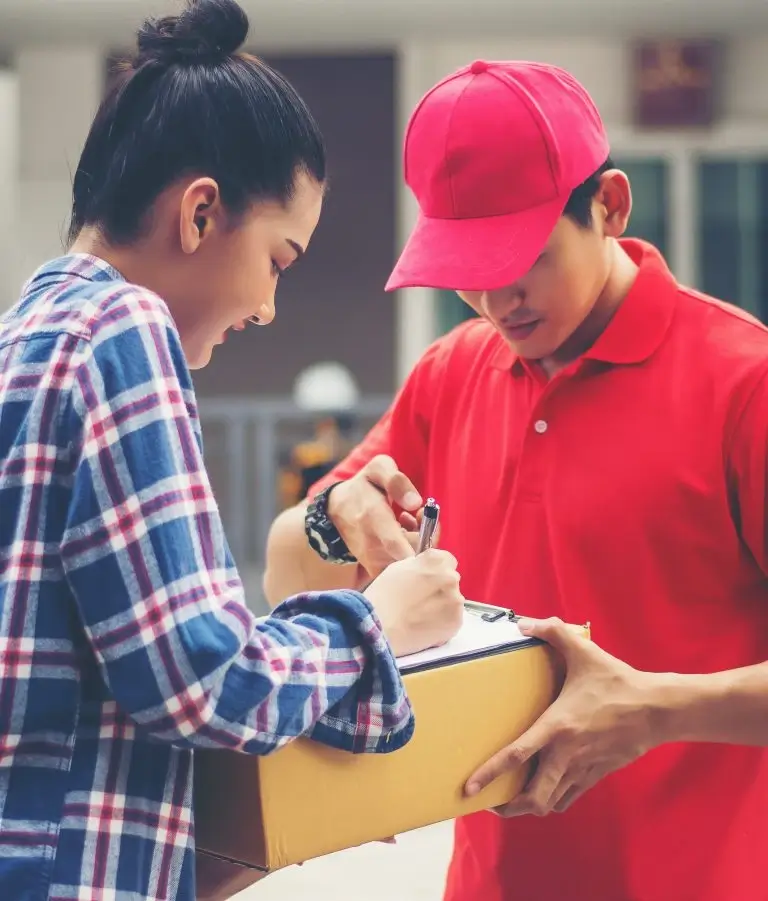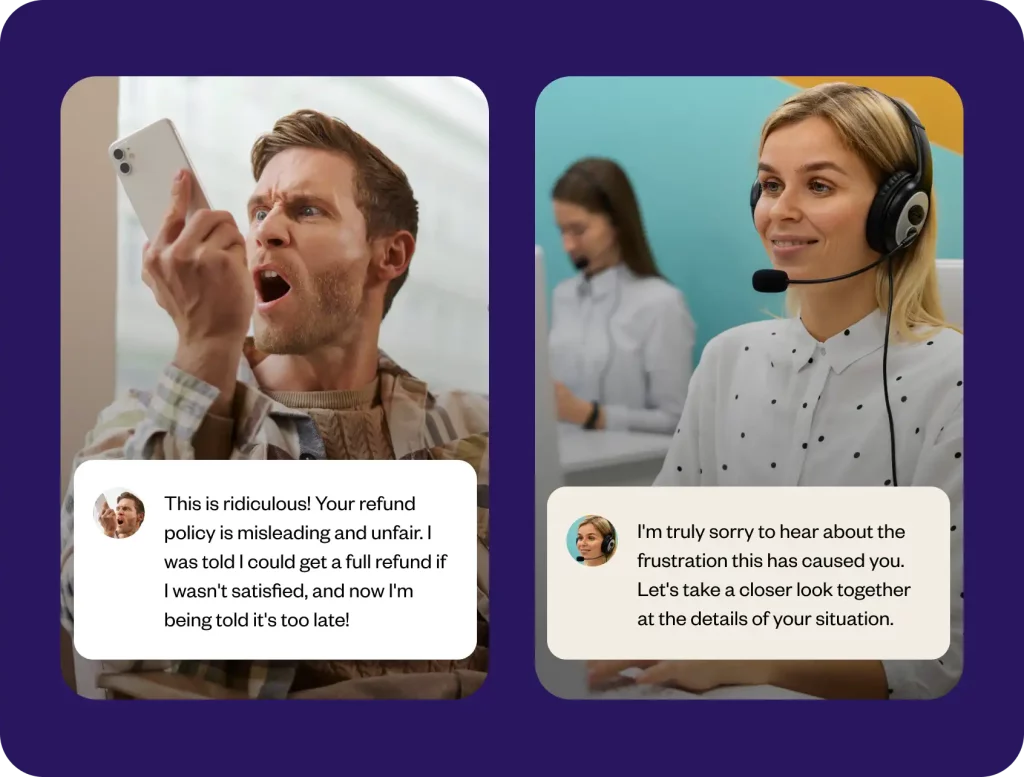Executive summary:
How to deal with a difficult customer: a question that torments even an established brand’s most seasoned customer service professional. In today’s hyper-connected world and digital realm, a single disgruntled voice can echo across the internet. The ability to navigate challenging interactions is no longer a nice-to-have; it’s a must-have. According to a survey of 700 consumers, 80% stated they would move to a rival due to poor customer service. It makes clear the significance of good customer service. This blog serves as your guide to conquering customer friction with confidence. We’ll delve into proven strategies and actionable tips, equipping you to convert difficult customers into loyal brand advocates.
Successfully tackling problematic consumers directly can improve your brand’s reputation. It will also give you insights into you how to avoid bad customer service. Keeping an adverse mindset will not help you solve challenges. You should approach each issue with the attitude that there is potential for growth and that the consumer complaining is a human who deserves to be heard.
Win reactive responses and emotional engagements. Master the art of learning how to actively listen, empathize, and problem-solve – all while maintaining a professional demeanor. This blog is a playbook to help you discover the power of tried-tested tools and effective communication to turn negative experiences into positive outcomes.
5 Types of difficult customers
Before you take the plunge into the troubled waters, try to identify various kinds of hard-to-please patrons. Let’s learn about five types of difficult customers who have certain visible signs, symptoms and patterns. As a customer service expert, you can tweak your approach and solution once you spot them.
Nevertheless, for those who wonder why even bother dealing with an adverse client, there are legitimate reasons. Some benefits include better brand recognition, customer retention, and word-of-mouth advertising. It may provide you constructive feedback that you may use to hone in on the weak spots of your customer support team. Now, let’s shift focus to distinct types of difficult customers.

1. The customer who complains frequently
Ever encountered a customer who seems to specialize in constructive criticism? The one flooding your inbox with detailed product suggestions and passionate opinions? These “complaining customers” can be a hidden blessing in disguise.
Identifying them is easy: frequent emails, customer feedback forms, or even social media rants paint a clear picture. But instead of rolling your eyes, consider this: their persistent interest reveals a genuine emotional investment in your brand, product, service and its potential.
Handling them effectively requires a shift in perspective, train your team to effectively:
- Acknowledge their concerns and validate their feelings. Let them know you hear them loud and clear.
- Ask questions to uncover the root of their frustration. Is it a feature lacking? Dig deeper beyond the initial complaint.
- Treat their feedback like any other valuable input. Don’t automatically discount it – track their suggestions and concerns.
- Respond to their messages. Share if their suggestion is being considered or is already on the roadmap.
Remember, while not every complaint will be actionable, these vocal optimists offer valuable insights. By engaging with them thoughtfully, you can turn their critiques into opportunities and build stronger relationships.
How can customer service automation help with frequently complaining customers?
AI-powered automation can not only help handle such customers, but also helps strengthen their engagement through each interaction by showing their input has a real impact. Automation tools such as conversational AI, AI-powered bots or even AI copilots can helps promptly identify whether the complaints stem from product misunderstandings, feature gaps, or other underlying frustrations, and automatically guiding the conversation intelligently to unearth the true cause of dissatisfaction.
That’s not all, AI systems can automatically log and categorize every complaint and suggestion, analyzing them to detect patterns or recurring issues. This process ensures customer feedback is systematically reviewed and considered for product improvements, demonstrating to customers that their input is valued and actionable, there by reducing the probability of more customers getting frustrated and reaching this state.
2. The customer who is hard-to-please
The “hard-to-please” customer: a specialist of dissatisfaction, finding fault where others find delight. While their negativity might feel like an icy reception, reflect, service combatants, every encounter presents an opportunity.
Getting to the heart of the matter: These individuals zero in on specific aspects of your product or service, often engaging in extended back-and-forth before acknowledging satisfaction. Remember, their negativity usually stems from high expectations, not a personal vendetta.
How to guide them:
- Acknowledge their frustration and validate their concerns. Show them you empathize, hear and understand their perspective.
- Don’t interrupt, instead be an active listener. Let them vent and express their dissatisfaction fully.
- Ask open-ended questions to understand their true wants and needs, not just what they complain about.
- Present realistic options as solutions that address their desires, even if it doesn’t meet every demand.
If they remain adamant, escalate wisely and consider involving a manager. Sometimes, a fresh stance can break the impasse.
How can customer service automation help with hard-to-please customers?
AI-powered customer service automation not only addresses the immediate challenges presented by hard-to-please customers but also leverages these interactions as opportunities for improvement and engagement, setting the stage for long-term loyalty and satisfaction.
AI chatbots, for example, excel at delivering truly personalized experiences by analyzing past interactions, preferences, and behaviors, AI can tailor communications and solutions to fit the unique needs and expectations of each customer. That’s not all, they learn and evolve from every interaction. This means the more they engage with hard-to-please customers, the better they become at predicting and meeting their expectations. Over time, this continuous improvement can significantly enhance the quality of customer service, making it more likely to meet even the highest standards.
Also, these types of customers often have high expectations for quick resolutions. AI automation ensures that these customers receive immediate responses and solutions, reducing wait times and increasing satisfaction. Speed, coupled with accuracy, demonstrates to customers that their time is valued, addressing one of the common frustrations in customer service.
3. The customer who is on the verge of churning
The “customer on the verge of churning” presents a critical juncture. They’re on the precipice, teetering between loyalty and the siren song of your competitor. But if you navigate it well, you can retain a valuable relationship. Studies reveal recurring consumers spend 67% more than new ones. Customer loyalty boosts revenue directly and gives your firm stability and predictability.
If you stumble and witness the dreaded churn rate climb, there are ways to get it under control.
Look for the telltale signs:
A bad experience was brought to your attention, perhaps coupled with interest in competitors. Be alert as you observe your customers’ engagement dwindle and increase interactions around alternatives or cancellations.
How to guide them:
- By actively identifying and engaging these at-risk customers, you transform potential churn into a loyalty-solidifying experience.
- Don’t wait for them to leave. Express genuine concern and solicit feedback through tailored communication.
- Involve higher-ups early. Brainstorm solutions – discounts, upgrades, special offers – that genuinely address their concerns.
- Keep them informed throughout the resolution process. Transparency and timely updates foster trust.
- Tailor your approach based on their specific journey and preferences.
How can customer service automation help with customers who are on the verge of churning?
Leveraging customer service automation can be pivotal in turning the tide and retaining their business. AI and machine learning algorithms excel at identifying patterns that indicate a customer is at risk of churning, such as decreased usage or negative feedback trends. By flagging these customers early, AI-powered systems can initiate proactive outreach efforts. Utilizing customer data, AI agents can craft personalized retention offers that are hard to refuse. Whether it’s a discount, a complimentary upgrade, or access to exclusive features, these targeted incentives can address the unique reasons behind each customer’s consideration to churn, making them feel valued and understood.
What’s more, for customers teetering on the edge, every interaction counts. AI-powered chatbots and virtual assistants can provide immediate, 24/7 support, answering queries, solving problems, and guiding customers through any issues they might face, on the channels and language of their preference. This level of responsiveness and efficiency can significantly improve their overall experience, encouraging them to stay.
4. The indecisive customer
The “indecisive customer” is a common breed in the customer service realm. They meander through options, peppering you with questions and leaving you wondering what they truly seek. Though frustrating, understanding their motivations is critical to navigating this labyrinth.
Spot them: Their communication is hazy, lacking specifics. They may not know precisely what they need, relying on you to offer solutions and fill in the blanks.
How to guide them:
- Ask clarifying questions and delve deeper. Uncover their true desires beyond the surface confusion.
- Avoid technical jargon and opt for clear, concise explanations. Tweak your communication to their level of understanding.
- Present or a decision-making framework. Help them visualize different paths to reach their goal.
- Listen, don’t push or get overly persuasive. Let them explore options independently, offering gentle guidance without feeling pressured.
- If they remain stuck, consider involving a colleague. It can sometimes break through the indecision.
- Remember, indecisiveness often stems from confusion or information overload. By actively listening, simplifying options, and offering support, you can help them discover the solution they seek.
How can customer service automation help with indecisive customers?
For the indecisive customer, who may waver in their decisions or seem unsure about committing to purchases, customer service automation powered by AI can be a significant asset in guiding them towards a confident decision. AI can analyze a customer’s browsing behavior, past purchases, and interactions to offer personalized product recommendations. This targeted approach helps narrow down options, making the decision-making process easier and more manageable for the customer.
What’s more, AI agents when they see the need can craft easy-to-use interactive decision trees that help customers identify their needs or preferences, leading them to products or services that best match their criteria. This engaging, guided experience reduces the overwhelm of choice, making decisions clearer and more straightforward. AI-powered bots can also provide indecisive customers with timely and pertinent informative content related to products or services they’re considering, such as how-to guides, FAQs, or comparison charts, in addition to reassurance through social proof, such as customer reviews, testimonials, or ratings to help build confidence in their decisions, reducing delays in decision-making.
5. The customer with unrealistic expectations
These individuals arrive armed with inflated expectations, often clashing head-on with reality. But fear not! There are strategies to untangle these knotty situations.
Recognizing the breed: They often-
- Demand features or capabilities outside your product’s scope. Think five-star service at a one-star price point.
- Express disappointment that your offerings don’t magically align with their unspoken desires. They haven’t researched, and the blame falls squarely on you.
- Negotiate aggressively, seeking discounts or upgrades beyond reason. Their motto: “Lower is always better, regardless of value.”
How to guide them:
- Actively listen for requests outside your scope. Gently but firmly communicate what’s realistic and what’s not. Don’t let expectations fester.
- Establish limitations upfront. Explain your product’s capabilities and pricing structure clearly. This avoids future frustration on both sides.
- Suggest upgrades or alternative solutions that meet their needs within your existing framework. Show you’re willing to help but within reason.
- Remember, it’s not personal. Stay calm! Don’t get dragged into heated discussions or unreasonable demands.
How can customer service automation help with customers who have unrealistic expectations?
For customers with sky-high expectations, AI-driven customer service automation is key in gently guiding them towards a more grounded understanding, while ensuring they remain satisfied and valued. By delivering precise, upfront information via AI, it sets achievable expectations from the start, clarifying what can be expected of products and services.
The system personalizes the educational content, ensuring customers understand what they’re getting into, helping realign their expectations without diminishing their experience. Proactively, AI identifies and addresses areas of potential discontent, offering realistic solutions to keep satisfaction levels high.
More importantly, through studying behavioral patterns and cues in shift in attitude, AI can help with rewarding customers who adjust their expectations. AI can identify opportunities to reward them, such as through loyalty points, discounts, or exclusive access to services. This not only encourages positive behavior but also reinforces the value of maintaining realistic expectations.
Lion Parcel elevates customer service with 85% automation powered by Generative AI

Tips and strategies for dealing with difficult customers
Once you have identified the type of difficult customer, it becomes easier to handle them. Though there are specialized approaches that excel with certain types of challenging customers, organizations can also benefit from implementing more generic techniques. Read on to explore some proven tips and strategies.

Before the interaction:
To provide effective customer service even to a difficult customer, try to segregate the action plan into stages of communication, such as before, during, and after interactions. Here are a few steps that can help your customer support team handle such customers better, while ensuring they leave feeling good about your brand.
Do the homework – get the context right
Acquiring product or service expertise is crucial for every customer service position since it directly impacts your ability to handle difficult customers. A firm foundation and proficiency are even more critical when dealing with a challenger. Learning about your consumers is another part of the “prepare in advance” philosophy. Before making a call, thoroughly review the customer’s profile. This background helps you predict their response.
Gather information
Before tackling challenging customer encounters, gathering relevant information such as the customer’s history, previous interactions, behavioral patterns, and specific concerns is essential. This holistic approach ensures a deeper understanding of their needs and preferences, enabling you to tailor your responses effectively. By collecting relevant details upfront, you’ll be able to confidently steer tricky situations and provide personalized solutions that resonate with the customer. Remember, thorough preparation lays the foundation for successful customer interactions.
Example: A difficult customer approaches your customer service team complaining about overcharging him. When handling such a billing dispute, review the customer’s payment history and previous inquiries to offer tailored solutions promptly.
Indigo succeeds in enhanced customer satisfaction

During the interaction:
It isn’t just about the pre-preparation that you need to master how to deal with a difficult customer. Specific essential skills and behavioral tools are required to deliver effective customer service during real-time interaction with an angry or not-so-friendly patron.
Maintain your composure
Facing a customer’s fiery email or phone call calmly isn’t easy. However, resist the urge to react defensively. Remember, their anger often masks frustration with your product or service, not a personal attack. You can turn a potentially heated situation into a positive outcome by staying calm. Try to discern: What’s the problem? What solutions can you offer? Likewise, validate their frustration without agreeing with their anger. Focus on finding a resolution that addresses their concerns. If it’s not feasible, present fair alternatives and explain the limitations clearly.
Example: A customer calls, furious about a delayed delivery. Instead of getting defensive, your rep says, “I know you are angry about the delay. Can you tell me more about what happened?” This acknowledges their frustration and opens the door to a productive conversation.
Practice active listening
Active listening goes a long way while dealing with a difficult customer. Instead of responding to their anger, the customer service representative must try to listen carefully to understand the root cause of the fury and resolve it efficiently. Ask them relevant questions targeted to the problem.
Example: A fuming customer calls your customer service center and says, “The air fryer your brand brags about is useless. Its touchscreen doesn’t work. I am shocked at how badly it is made.” Instead of replying, “I understand your frustration!” focus on the customer’s expression, which emphasizes ‘being shocked’. Use the same terminology as your consumer. “That is shocking! Let’s find out why your product has suddenly ceased functioning.”
Empathize with the customer
Empathy holds the key to resolving conflicts with difficult customers. You can better comprehend their frustrations and concerns by putting yourself in their shoes. Instead of dismissing their complaint, acknowledge their disappointment and assure them you’re committed to finding a solution. Empathetic approach exhibits genuine care and can help defuse tense situations.
Example: A customer is contacting the customer service division of your e-commerce store to express frustration over receiving a damaged product. Instead of just apologizing and offering a refund, you could empathize with their dismay by saying, “I resonate with you how frustrating it must be to receive a damaged item. I’m honestly sorry for the inconvenience this has caused you.”
Focus on solving the problem
While dealing with difficult customers, shift the focus from the issue to finding a resolution. Concentrate on how to set it right rather than dwelling on what went wrong. As McKinsey found, 70% of purchase experiences depend on customer treatment. Hence, your attitude towards them is a huge deal. Be proactive in addressing the customer’s needs and rectifying errors promptly. Emphasis on problem-solving shows outstanding customer service.
Example: A client reaches out to you, encountering technical glitches with your software application; focus on resolving it swiftly. You might say, “I’m committed to getting this sorted out for you immediately. Let’s troubleshoot the issue together to identify the root cause and find the best solution for you.”
Offer options
Sometimes, you might land in a situation where you must deal with a problematic customer adamant about an impossible solution. But this is where your expert customer service team skills come in handy. Customers may get perturbed when they see minimal options. Remember, you can always make the best out of an unfavorable situation drawing inspiration from Service Recovery Paradox. Give them several solutions to ease their anxieties. Options empower them and demonstrate your flexibility.
Example: A customer contacts your retail store, dissatisfied with a recent purchase due to size issues. Instead of insisting on a return, offer alternative solutions such as exchanging for a different size, providing a store credit, or recommending complementary items. By presenting options, you authorize the customer to pick the solution aligning to their priorities.
Communicate clearly and concisely
Effective communication is essential in diffusing pressure and resolving conflicts. When interacting with difficult customers, communicate clearly and concisely, avoiding jargon or ambiguous language. Be transparent about timelines, expectations, and any steps to resolve the issue.
Example: A client calls your consulting business about project delays. Avoid unclear replies and disregard commitments by being open. Say, “I’ll explain the situation and how we address delays. Let me explain our new timetable and project acceleration measures.”
Be patient
Patience is a must, especially when dealing with challenging customers. You remain calm, composed, and patient despite their frustrations throughout the interaction. Avoid reacting impulsively or becoming defensive, as this can escalate tensions further. Validate the customer’s concerns and reassure them you’re working towards a solution.
Example: A furious consumer calls your telecom firm about internet issues. Be patient despite their frenzy. Avoid jumping to conclusions or interrupting the speaker. Instead, hear their worries and ensure you’ll resolve the matter to their satisfaction.
Additional tips
Use “I” statements
In customer service, the onus is on the team to make the customer feel valued and respected, even in an adverse situation. Thus, employing “I” statements can create a sense of empathy and the sense that you are taking personal responsibility to sort their issue out.. Instead of engaging in a blame-game or pointing fingers, frame your responses in a way that emphasizes personal accountability and an interest in addressing the problem. For instance,

Angry Customer: “This is ridiculous! Your refund policy is misleading and unfair. I was told I could get a full refund if I wasn’t satisfied, and now I’m being told it’s too late!”
Customer Service Agent: “I’m truly sorry to hear about the frustration this has caused you. Let’s take a closer look together at the details of your situation.
Our policy does allow for refunds under certain conditions, and I’m here to help clarify those and work through this with you. Can we start by discussing the specifics of your purchase and the issues you’ve encountered? I’m here to help make this right.”
Here, the customer service representative acknowledges the customer’s feelings and starts with an apology and expressing a sincere desire to resolve the issue acknowledges the customer’s frustration without immediately jumping to the defense of the policy. This kind of handling will not only help the customer feel like they’re being taken seriously, it would also indicate the company wants collaboration and the customer is seen as partners in finding a resolution, rather than adversaries in a difficult scenario.
Offer apologies
While dealing with a difficult customer, an honest apology can pacify the situation. It is easy to go off the rails when dealing with disrespectful clients. You may end up responding to their resentment with a fake “sorry” or over-apologize and babble. Instead, develop your middle ground to feel natural in stressful situations. Salesforce says 78% of customers will return to a firm with excellent customer service, even after a mistake. Great customer service through apology when needed may turn unpleasant experiences around, as seen by this statistic.
Example: A peeved customer calls again for not receiving a parcel even after the promised period of one week of delivery. Say nothing like “That is an awful error. I apologize deeply for this terrible situation.” Instead, keep calm and say, “I’m sorry our team didn’t sort out your issue yesterday.” That delivery time didn’t satisfy our high requirements. Let’s resolve this now.”
Humor can be helpful (but use it carefully)
It might sound a tad unconvincing, but using humor judiciously and sensitively to the customer’s mood can ease tension and lead to a more positive interaction. It can serve as a powerful tool while dealing with difficult customers. However, it’s essential to employ carefully and sense the customer’s receptiveness before incorporating humor into your interactions. Use light-hearted jokes or anecdotes acknowledging the customer’s dissatisfaction and lighten the conversation.
Frustrated Customer: “I ordered my package two weeks ago, and it’s still not here. This is the second time it’s been delayed! What’s going on with your shipping?”
Customer Service Agent: “I’m really sorry for the wait and totally understand your frustration. It does seem like your package decided to embark on an unexpected adventure of its own. Rest assured, I’m here as the travel guide to ensure its journey ends at your doorstep, and soon. Let me quickly check on its current whereabouts and see how we can expedite its homecoming. I promise, we’ll make sure it arrives not just with everything you’ve been waiting for but also with a story to tell about its grand tour!”
This response accomplishes several things:
Acknowledges the customer’s feelings: The response begins with an apology and validation of the customer’s frustration, establishing an empathetic tone.
Injects humor: By suggesting the package is on an “unexpected adventure” and that the service representative is its “travel guide,” the reply lightly plays with the situation without diminishing the customer’s concerns. This approach can lighten the mood, but it’s crucial to first gauge the customer’s openness to humor.
Promises action: The response assures the customer that the issue is being taken seriously and that immediate action will be taken to resolve the problem.
Maintains professionalism: While employing humor, the reply remains professional and focused on solving the issue, ensuring the customer feels supported and valued.
Using humor like this can turn a potentially negative interaction into a more positive experience, but always be mindful of the customer’s mood and the context of the situation to ensure the humor is appropriate and well-received.
Know when to escalate
Stalemates can emerge in client engagements when resolution seems impossible or the interaction grows ugly, offensive or unproductive, no matter what you do. In such cases, it’s integral to determine when to escalate the situation to a higher authority or specialized team within your organization. Calmly explain that you will involve a manager or superior better equipped to assist them.
Example: If a demanding customer isn’t satisfied with your responses, you can still attend to the need by involving a senior. You may say, “I want to find a solution that suits you. Let me put you in touch with my supervisor, who can investigate further possibilities and help.”
After the interaction:
As you identify different types of difficult customers and employ strategies to deal with them before engaging in interaction and also during the conversation, you must consider what you learn after such communications.
Learn from the experience
One possible takeaway or learning from dealing with difficult customers is how to handle common problems. In training new service representatives, it helps them solve problems swiftly and think fast. Challenging conversations may yield the most valuable suggestions for improving contact center training and the areas your products and services need betterment.
How Yellow.ai can help you automate your customer support function to deliver exceptional customer service?
Although a TCN research found that 69% of Americans prefer live agent chats for customer support, automating this division, especially for repetitive and tedious tasks, has gained immense popularity. In fact, a 2022 Benchmark survey reveals that 91% of US contact center leaders prioritize automation to combat growing expenses, employment issues, and call volume surges.
Let us tell you why Yellow.ai can be strongest partner in automating customer support and why it’s a game-changer for your enterprise. Imagine slashing your operational costs by a whopping 60% while handling 90% of customer queries like a boss across 35+ platforms. Sounds too good to be true? Stick with us.
- No-fuss integrations and deployments – Yellow.ai isn’t just another tool in your tech stack—it’s the MVP that plays well whether you’re integrating it with what you already have (Zendesk? Freshdesk? Genesys? Any other existing tech ecosystem? We’ve got you.)or letting it run the show solo. Setting it up is a breeze, too. Forget about code or manual headaches. With over 100 integrations ready to go and 150+ templates to choose from, you’re all set in no time. Say goodbye to the old days of clunky, half-baked automation attempts.
- Unified brand tone through omnichannel support – Now, for the secret sauce: bleeding-edge AI-powered bots that can chat and talk with incredibly human-like understanding, empathy and tones to offering truly personalized, contextual support 35+ channels and 135+ global languages, 24/7.
- A truly ahead of the curve platform: Our Dynamic Automation Platform trains on over 16 billion conversations every year and is constantly self-learning and improving. That’s billion with a ‘B’—making its data set richer than a triple chocolate cake and its models sharper than your kitchen knives. The result? Top-notch recognition rates that really get your customers.
- Faster time-to-value: with Yellow.ai, you’re not just getting technology that’s leagues ahead in the industry; you’re unlocking faster time-to-value. Our robust professional services have propelled countless global brands into the stratosphere of customer service. We’re talking transformation and scaling at its finest.
- Safe AI: And because we know security is everything, Yellow.ai brings its A-game with enterprise-grade security measures like ISO, HIPAA, SOC2, and GDPR certifications, keeping your data locked down tighter than Fort Knox.
Wow your customers while boosting agent productivity and savings.

Conclusion
Navigating the choppy waters of difficult customer interactions can be a daunting task. Yet, within the storm lies an unexpected treasure: the opportunity to turn frustration into loyalty. Remember, behind the anger, there’s often a human story. Active listening and genuine empathy are your life rafts. Acknowledge their frustration, understand their perspective, and get to the root of the issue before diving into solutions.
Difficult customers are valuable mirrors: their feedback, however harsh, reveals areas for improvement. By listening to their concerns, you gain invaluable insights to enhance your product or service, strengthening your business structure. Patience and respect are your anchors. Tailor your approach based on their communication style, remembering they’re human too. A genuine connection, even amidst the storm, can foster positive, memorable customer experiences.
Remember customers being difficult isn’t a personal attack but rather an opportunity to grow and transform your brand and its offerings through feedback from invested perspectives. Compassion, and a focus on solutions may transform them into loyal customers who will rave about your customer service and your brand’s ethos.
















